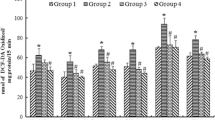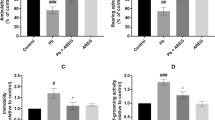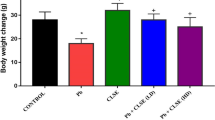Abstract
Lead exposure is known to cause apoptotic neurodegeneration and neurobehavioral abnormalities in developing and adult brain by impairing cognition and memory. Coriandrum sativum is an herb belonging to Umbelliferae and is reported to have a protective effect against lead toxicity. In the present investigation, an attempt has been made to evaluate the protective activity of the hydroalcoholic extract of C. sativum seed against lead-induced oxidative stress. Male Wistar strain rats (100–120 g) were divided into four groups: control group: 1,000 mg/L of sodium acetate; exposed group: 1,000 mg/L lead acetate for 4 weeks; C. sativum treated 1 (CST1) group: 250 mg/kg body weight/day for seven consecutive days after 4 weeks of lead exposure; C. sativum treated 2 (CST2) group: 500 mg/kg body weight/day for seven consecutive days after 4 weeks of lead exposure. After the exposure and treatment periods, rats were sacrificed by cervical dislocation, and the whole brain was immediately isolated and separated into four regions: cerebellum, hippocampus, frontal cortex, and brain stem along with the control group. After sacrifice, blood was immediately collected into heparinized vials and stored at 4 °C. In all the tissues, reactive oxygen species (ROS), lipid peroxidation products (LPP), and total protein carbonyl content (TPCC) were estimated following standard protocols. An indicator enzyme for lead toxicity namely delta-amino levulinic acid dehydratase (δ-ALAD) activity was determined in the blood. A significant (p < 0.05) increase in ROS, LPP, and TPCC levels was observed in exposed rat brain regions, while δ-ALAD showed a decrease indicating lead-induced oxidative stress. Treatment with the hydroalcoholic seed extract of C. sativum resulted in a tissue-specific amelioration of oxidative stress produced by lead.









Similar content being viewed by others
References
Brannvall ML, Bindler R, Renberg I, Emteryd O, Bartnicki J, Billstrom K (1999) The medieval metal industry was the cradle of modern large scale atmospheric lead pollution in northern Europe. Environ Sci Technol 33:4391–4395
Jomovo K, Valko M (2011) Advances in metal-induced oxidative stress and human disease. Toxicol 283:65–87
Lee JC, Son YK, Pratheeshkumar P, Shi X (2012) Oxidative stress and metal carcinogenesis. Free Radic Biol Med 53:742–757
Wang Y, Fang J, Huang S, Chen L, Fan G, Wang C (2013) The chronic effects of low lead level on the expressions of Nrf2 and Mrp1 of the testes in the rats. Environ Toxicol Pharmacol 35:109–116
Adonaylo VN, Oteiza PI (1999) Lead intoxication: antioxidant defenses and oxidative stress in rat brain. Toxicol 135(3):77–85
Fracasso ME, Perbellini L, Solda S, Talamini G, Franceschetti P (2002) Lead induced DNA strand breaks in lymphocytes of exposed workers: role of reactive oxygen species and protein kinase C. Mutat Res 515:159–169
Bokara KK, Brown E, Mc Cormick R, Yallapragada PR, Sharada R, Rajanna B (2008) Lead-induced increase in antioxidant enzymes and lipid peroxidation products in developing rat brain. Biometals 21:9–16
Bokara KK, Blaylock L, Denise SB, Bettaiya R, Rajanna S, Yallapragada PR (2009) Influence of lead acetate in glutathione and its related enzymes in different regions of rat brain. J Appl Toxicol 29:452–458
Kiran Kumar B, Prabhakara Rao Y, Noble T, Weddington K, Mc Dowell VP, Rajanna S, Bettaiya R (2009) Lead-induced alteration of apoptotic proteins in different regions of adult rat brain. Toxicol Let 184:56–60
Sharma V, Kansal L, Sharma A (2010) Prophylactic efficacy of Coriandrum sativum (coriander) on testis of lead-exposed mice. Biol Trace Elem Res 36:337–354
Mehana EE, Meki ARMA, Fazili KM (2012) Ameliorated effects of green tea on lead-induced liver toxicity in rats. Expt Toxicol Pathol 64:291–295
Abdel Moneim AE (2012) Flaxseed oil as a neuroprotective agent on lead acetate-induced monoamineric alterations and neurotoxicity in rats. Biol Trace Elem Res 148:363–370
Wang J, Yang Z, Lin L, Zhao Z, Liu Z, Liu X (2012) Protective effect of naringenin against lead-induced oxidative stress in rats. Biol Trace Elem Res 146:354–359
Li HW, Deng JG, Du ZC, Yan MS, Long ZX, Thi PTP, Yang KD (2013) Protective effects of mangiferin in subchronic developmental lead-exposed rats. Biol Trace Elem Res 155:233–242
Flora G, Gupta D, Tiwari A (2013) Preventive efficacy of bulk and nanocurcumin against lead-induced oxidative stress in mice. Biol Trace Elem Res 152:31–40
Zhang Y, Li Q, Liu X, Zhu H, Song A, Jiao J (2013) Antioxidant and micronutrient-rich milk formula reduces lead poisoning and related oxidative damage in lead-exposed mice. Food Chem Toxicol 57:201–208
Al-Mofleh IA, Alhaider AA, Mossa JS, Al-Sohaibani MO, Rafatullah S, Qureshi S (2006) Protection of gastric mucosal damage by Coriandrum sativum L. pretreatment in Wistar albino rats. Environ Toxicol Pharmacol 22:64–69
Mani V, Parle M, Ramasamy K, Majeed ABA (2011) Removal of memory deficits by Coriandrum sativum leaves in mice. J Sci Food Agric 91(1):186–192
Rakhshandeh H, Sadeghnia HR, Ghorbani A (2012) Sleep-prolonging effect of Coriandrum sativum hydro-alcoholic extract in mice. Nat Prod Res 26(22):2095–2098
Wong PYY, Kitts DD (2006) Studies on the dual antioxidant and antibacterial properties of parsley and cilantro extracts. Food Chem 97:505–515
Platel K, Srinivasan K (2000) Stimulatory influence of select spices on bile secretion in rats. Nutr Res 20(10):1493–1503
Wangensteen H, Samuelsen AB, Malterud KE (2004) Antioxidant activity in extracts from coriander. Food Chem 88:293–297
Cantore PL, Lacobellis NS, Marco AD, Capassa F, Senatore F (2004) Antibacterial activity of Coriandrum sativum L. and Foeniculum vulgare Miller var. vulgare (Miller) essential oils. J Agric Food Chem 52:7862–7866
Mahendra P, Bisht S (2011) Anti-anxiety activity of Coriandrum sativum assessed using different experimental anxiety models. Ind J Pharmacol 43(5):574–577
Chithra V, Leelamma S (1999) Coriandrum sativum—mechanism of hypoglycemic action. Food Chem 67:229–231
Patel DK, Desai SN, Gandhi HP, Devkar RV, Ramachandran AV (2012) Cardio protective effect of Coriandrum sativum L. on isoproterenol induced myocardial necrosis in rats. Food Chem Toxicol 50:3120–3125
Budvari S (1996) The Merck index: an encyclopedia of chemicals, drugs and biologies, 12th edn. Merck and Co Inc., Whitehouse Station New Jersey
Burdock GA, Carabin IG (2008) Safety assessment of coriander (Coriandrum sativum L) essential oil as a food ingredient. Food Chem Toxicol 47:22–34
Ceska O, Chaudhary SK, Warrington P, Ashwood-Smith MJ, Bushnell GW, Poultoni GA (1988) Coriandrin, a novel highly photoactive compound isolated from Coriandrum sativum. Phytochem 27(7):2083–2087
Samojlik I, Lakic N, Mimica-Dukic N, Dakovic-Svajcer K, Bozin B (2010) Antioxidant and hepatoprotective potential of essential oils of coriander (Coriandrum sativum L.) and caraway (Carum carvi L.) (Apiaceae). J Agric Food Chem 58:8848–8853
Ren H, Jia H, Kim S, Maita M, Sato S, Yasui M, Endo H, Hayashi T (2006) Effect of Chinese parsley Coriandrum sativum and chitosan on inhibiting the accumulation of cadmium in cultured rainbow trout Oncorhynchus mykiss. Fish Sci 72:263–269
Jia H, Ren H, Endo H, Hayashi T (2009) Effect of Chinese parsley Coriandrum sativum on cadmium binding to proteins from the liver and kidney of rainbow trout Oncorhynchus mykiss. Marine Freshwater Behaviour Physiology 42(3):187–199
Karunasagar D, Balarama Krishna MV, Rao SV, Arunachalam J (2005) Removal and preconcentration of inorganic and methyl mercury from aqueous media using a sorbent from the plant Coriandrum sativum. J Hazardous Materials 118(1–3):133–139
Sharma V, Kansal L, Sharma A, Lodi S, Sharma SH (2011) Ameliorating effect of Coriandrum sativum extracts on hematological and immunological variables in an animal model of lead intoxication. J Pharm All Health Sci 1(1):16–29
Sreelatha S, Padma PR, Umadevi M (2009) Protective effects of Coriandrum sativum extracts on carbon tetra chloride-induced hepatotoxicity in rats. Food Chem Toxicol 47:702–708
Talapatra SN, Dasgupta S, Guha G, Auddy M (2010) Therapeutic efficacies of Coriandrum sativum aqueous extract against metronidazole-induced genotoxicity in Channa punctatus peripheral erythrocytes. Food Chem Toxicol 48:3458–3461
Manoj Kumar V, Dale W, Prabhakara Rao Y, Rajanna S, Rajanna B (2013) Protective role of Coriandrum sativum seed extract against lead-induced oxidative stress in rat liver and kidney. Curr Trends in Biotech and Pharm 7(2):650–664
Bondy SC, Guo SX (1996) Lead potentiates iron-induced formation of reactive oxygen species. Toxicol Let 87(2–3):109–112
Ohkawa H, Ohisi N, Yagi K (1979) Assay for lipid peroxides in animal tissues by thiobarbituric acid reaction. Anal Biochem 95(2):351–358
Levine RL, Garland D, Oliver CN, Amici A, Climent I, Lenz A, Ahn B, Shaltiel S, Stadtman ER (1990) Determination of carbonyl content in oxidatively modified proteins. Met Enzymol 186:464–478
Berlin A, Schaller KH (1974) European standardized method for the determination of delta aminolevulinic acid dehydratase activity in blood. Zeitschrift fur Klinische Chemie Klinische Biochemie 12:389–390
Zachariadis GA, Stratis JA, Kaniou I, Kalligas G (1995) Critical comparison of wet and dry digestion procedures for trace metal analysis of meat and fish tissues. Microchimica Acta 119:3–4
Sanfeliu C, Sebastian J, Kim SU (2001) Methylmercury neurotoxicity in cultures of human neurons, astrocytes, neuroblastoma cells. Neurotoxicol 22:317–327
Halliwell B, Gutteridge JMC (1989) Free radicals in biology and medicine, 2nd edn. Clarendon Press, Oxford, UK
Marnett LJ (1999) Lipid peroxidation-DNA damage by malondialdehyde. Mutat Res Fund Mol Mech Mutagen 424:83–95
Kunzemann J, Herrmann K (1977) Isolation and identification of flavon(ol)-O-glycosides in caraway (Carum carvi L.), fennel (Foeniculum vulgare Mill.), anise (Pimpinella anisum L.), and coriander (Coriandrum sativum L.), and of flavon-C-glycosides in anise. I. Phenolics of spices. Zeitschrift fur Lebensmitteluntersuchung und forschung A 164(3):194–200
Nagata H, Takekoshi S, Takagi T, Honma T, Watanabe K (1999) Antioxidative action of flavonoids, quercetin and catechin, mediated by the activation of glutathione peroxidase. Tokai J Expt Clin Med 24:1–11
Rohrdanz E, Ohler S, Tran-Thi QH, Kahl R (2002) The phytoestrogen daidzein affects the antioxidant enzyme system of rat hepatoma H4IIE cells. J Nutr 132(3):370–375
Shalan MG, Mostafa MS, Hassouna MM, El-Nabi SE (2005) Amelioration of lead toxicity on rat liver with vitamin C and silymarin supplements. Toxicol 206(1):1–15
Patra RC, Swarup D, Dwivedi SK (2001) Antioxidant effects of alpha-tocopherol, ascorbic acid and l-methionine on lead induced oxidative stress to the liver, kidney and brain in rats. Toxicol 162:81–88
Jurczuk M, Moniuszko-Jakoniuk J, Brzˇıoska MM (2006) Involvement of some low-molecular thiols in the peroxidative mechanisms of lead and ethanol action on rat liver and kidney. Toxicol 219:11–21
Patrick L (2006) Lead toxicity part II. The role of free radical damage and the use of antioxidants in the pathology and treatment of lead toxicity. Altern Med Rev 11(2):114–127
Hashim MS, Lincy S, Remya V, Teena M, Anila L (2005) Effect of polyphenolic compounds from Coriandrum sativum on H2O2-induced oxidative stress in human lymphocytes. Food Chem 92:653–660
Anilakumar KR, Nagaraj NS, Santhanam K (2001) Effect of coriander seeds on hexachlorocyclohexane induced lipid peroxidation in rat liver. Nutr Res 21:1455–1462
Tanabe H, Yoshida M, Tomita N (2002) Comparison of the antioxidant activities of 22 commonly used herbs and spices on the lipid oxidation of pork meat. Anim Sci J 73:389–393
Nevin KG, Vijayammal PL (2005) Effect of Aerva lanata on solid tumor induced by DLA cells in mice. Fitoterapia 74:578–580
Liu CM, Zheng YL, Lu J, Zhang ZF, Fan SH, Wu DM, Ma JQ (2010) Quercetin protects rat liver against rat liver against lead-induced oxidative stress and apoptosis. Environ Toxicol Pharmacol 29(2):158–166
Velaga MK, Basuri CK, Robinson Taylor KS, Yallapragada PR, Rajanna S, Rajanna B (2013) Ameliorative effects of Bacopa monniera on lead-induced oxidative stress in different regions of rat brain. Drug Chem Toxicol 1-8 DOI: 10.3109/01480545.2013.866137
Flora SJS, Mittal M, Mehta A (2008) Heavy metal induced oxidative stress & its possible reversal by chelation therapy. Indian J Med Res 128:501–523
Tomokuni K, Ichiba M, Hirai Y (1991) Elevated urinary excretion of beta-aminoisobutyric acid and delta-aminolevulinic acid (ALA) and the inhibition of ALA-synthase and ALA-dehydratase activities in both liver and kidney in mice exposed to lead. Toxicol Let 59:169–173
Tomokuni K, Hirai Y, Ichiba M (1991) Fluorophotometric determination of hepatic δ-aminolevulinic acid synthase activity by high-performance liquid chromatography. J Chromatogr 567:65–70
Aga M, Iwaki K, Ueda Y, Ushio S, Masaki N, Fukuda S, Kimoto T, Ikeda M, Kurimoto M (2001) Preventive effect of Coriandrum sativum (Chinese parsley) on localized lead deposition in ICR mice. J Ethnopharmacol 77:203–208
Pande M, Mehta A, Pant BP, Flora SJS (2001) Combined administration of a chelating agent and an antioxidant in the prevention and treatment of acute lead intoxication in rats. Environ Toxicol Pharmacol 9:173–184
Heim KE, Tagliaferro AR, Bobilya DJ (2002) Flavonoid antioxidants: chemistry, metabolism and structure-activity relationships. J Nutr Biochem 13:572–584
Ren H, Jia H, Endo H, Hayashi T (2009) Cadmium detoxification effect of Chinese parsley Coriandrum sativum in liver and kidney of rainbow trout Oncorhynchus mykiss. Fish Sci 75:731–741
Connor JR, Menzies SL (1996) Relationship of iron to oligodendrocytes and myelination. Glia 17(2):83–93
Takeda A (2001) Zinc homeostasis and function of zinc in the brain. Biometals 14(3–4):343–351
Molin Y, Erisk P, Ilback NG (2008) Sequential effects of daily arsenic trioxide treatment on essential and nonessential trace elements in tissues in mice. Anticancer Drugs 19(8):812–818
Liu X, Nordberg GF, Jin T (1992) Increased urinary excretion of zinc and copper by mercury chloride injection in rats. Biometals 5(1):17–22
Madsen E, Gitlin JD (2007) Copper and iron disorders of the brain. Annu Rev Neurosci 30:317–337
Zheng W, Monnot AD (2012) Regulation of brain iron and copper homeostasis by brain barrier systems: implication in neurodegenerative diseases. Pharmacol Ther 133(2):177–188
Wang L, Xu ZR, Jia XY (2006) Effects of dietary arsenic levels on serum parameters and trace metal retentions in growing and finishing pigs. Biol Trace Elem Res 113(2):155–164
Wang X, Zhang J, Zhao L, Hu S, Piao F (2013) Effect of subchronic exposure to arsenic on levels of essential trace elements in mice brain and its gender difference. Biometals 26:123–131
Acknowledgments
This work was supported by NIH/NCMHD/MHIRT, Grant no. 9 T37MD001532 awarded to Bettaiya Rajanna at Alcorn State University, MS, USA. Dale Williams was MHIRT (Minority Health International Research Training) undergraduate student participant. The authors thank the administration of Andhra University for providing research facilities for this international collaboration of undergraduate research program for students.
Conflict of Interest
The authors declare that they have no conflict of interest.
Author information
Authors and Affiliations
Corresponding author
Rights and permissions
About this article
Cite this article
Velaga, M.K., Yallapragada, P.R., Williams, D. et al. Hydroalcoholic Seed Extract of Coriandrum sativum (Coriander) Alleviates Lead-Induced Oxidative Stress in Different Regions of Rat Brain. Biol Trace Elem Res 159, 351–363 (2014). https://doi.org/10.1007/s12011-014-9989-4
Received:
Accepted:
Published:
Issue Date:
DOI: https://doi.org/10.1007/s12011-014-9989-4




